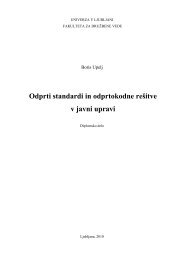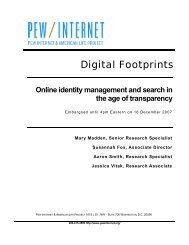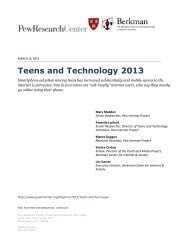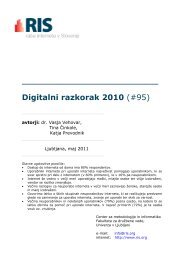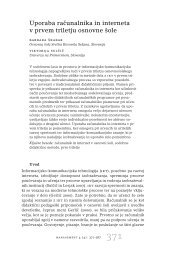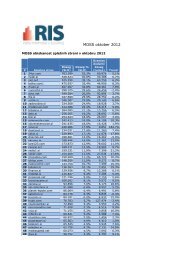the Labour Market Survey Report - Council of European ...
the Labour Market Survey Report - Council of European ...
the Labour Market Survey Report - Council of European ...
You also want an ePaper? Increase the reach of your titles
YUMPU automatically turns print PDFs into web optimized ePapers that Google loves.
The IDC approach is based on estimates <strong>of</strong> IT system development and service delivery activity and an<br />
assumed human resource requirement (in terms <strong>of</strong> “full-time equivalents”) to staff this activity. As is inevitable<br />
in such an approach, <strong>the</strong> occupational classification assumed is in reality more <strong>of</strong> a functional classification.<br />
It uses a unique, apparently forward-looking, classification, involving 3 broad categories <strong>of</strong> skill:<br />
• ICT skills,<br />
• e-Business skills, and<br />
• Call Centre skills.<br />
The ICT skills category is split into (those required for) five different types <strong>of</strong> computing (“technology<br />
environment”):<br />
• “Internetworking” (Internet protocol environments; networking infrastructures)<br />
• “Applications” (application s<strong>of</strong>tware development and delivery)<br />
• “Distributed” (centred on client-server infrastructures)<br />
• “Technology-neutral” (IT business consultancy: work to align clients’ IT and business<br />
processes)<br />
• “Host-based” (centred on large server environments)<br />
And e-Business skills are deemed to consist <strong>of</strong>:<br />
• “Internet strategists”<br />
• “Internet-dependent” activities<br />
While <strong>the</strong> approach to composition <strong>of</strong> demand is interesting and <strong>the</strong> categories chosen are useful in<br />
relation to <strong>the</strong> way IT business is categorized, <strong>the</strong>y are not a particularly valid split <strong>of</strong> skill requirements,<br />
and <strong>the</strong>y suffer from <strong>the</strong>ir uniqueness. As a result, <strong>the</strong>re is no way <strong>of</strong> relating <strong>the</strong>m to, testing<br />
<strong>the</strong>m against, or above all reconciling <strong>the</strong>m with more robust estimates based on widely accepted<br />
classifications <strong>of</strong> distinct occupational skill requirements. Specifically, IDC have made no attempt to<br />
relate <strong>the</strong> “full-time-equivalent” estimates <strong>the</strong>y provide for current and recent years with <strong>the</strong> realities <strong>of</strong><br />
<strong>the</strong> numbers known to be in employment. For example, <strong>the</strong> figures given in <strong>the</strong> EITO 2001 for <strong>the</strong> supply<br />
<strong>of</strong> ICT skills in <strong>the</strong> United Kingdom in 1999 and 2000 are seriously unrealistic in relation to what is known<br />
<strong>of</strong> employment levels in <strong>the</strong> UK ICT Practitioner labour market (see Annex A). This inevitably raises real<br />
doubt as to <strong>the</strong> validity (indeed meaning) <strong>of</strong> <strong>the</strong> estimates for <strong>the</strong> future, especially at <strong>the</strong> <strong>European</strong><br />
level, and knowledgeable industry and labour market commentators in different <strong>European</strong> countries<br />
remain sceptical about <strong>the</strong> excessive magnitude <strong>of</strong> <strong>the</strong>se figures. For example, <strong>the</strong> total number <strong>of</strong> IT<br />
Practitioners in <strong>the</strong> UK (as specified by <strong>the</strong> sum <strong>of</strong> <strong>the</strong> figures for <strong>the</strong> five SOC-90 codes that cover all<br />
direct IT roles – see Annex A) were, in 1999 and 2000, a little over ½ <strong>of</strong> <strong>the</strong> IDC estimated supply total<br />
for just <strong>the</strong>ir “ICT skills” categories*.<br />
* IDC acknowledges that its approach is based on making “technology forecasts relating to product shipments,<br />
and <strong>the</strong>n attaching work-rates to <strong>the</strong> shipment <strong>of</strong> IT products”… <strong>the</strong> estimates are asserted to be “based on <strong>the</strong><br />
‘real’ amount <strong>of</strong> work (in person-hours) necessary to make IT products work effectively”. “This means that IT work<br />
undertaken by, for example, an <strong>of</strong>fice manager would be included in <strong>the</strong> numbers and that <strong>of</strong>fice manager might be<br />
.3 <strong>of</strong> an IT pr<strong>of</strong>essional” (quoted in Mason, 2000). While even this approach would be unlikely to result in anywhere<br />
near <strong>the</strong> effective doubling <strong>of</strong> <strong>the</strong> workforce that <strong>the</strong> discrepancy in <strong>the</strong> figures would require, <strong>the</strong> view taken in this<br />
study is that <strong>the</strong> requirements for IT Practitioner skills are fundamentally different from those <strong>of</strong> IT End-Users (see<br />
Annex A), so that <strong>the</strong> <strong>of</strong>fice manager given in IDC’s example would not need higher education, or technical training/<br />
experience <strong>of</strong> an IT Practitioner to perform <strong>the</strong> functions carried out in <strong>the</strong> .3 <strong>of</strong> his/her job indicated.<br />
C E P I S I.T. PRACTITIONER SKILLS IN EUROPE | Section 5 | 73



